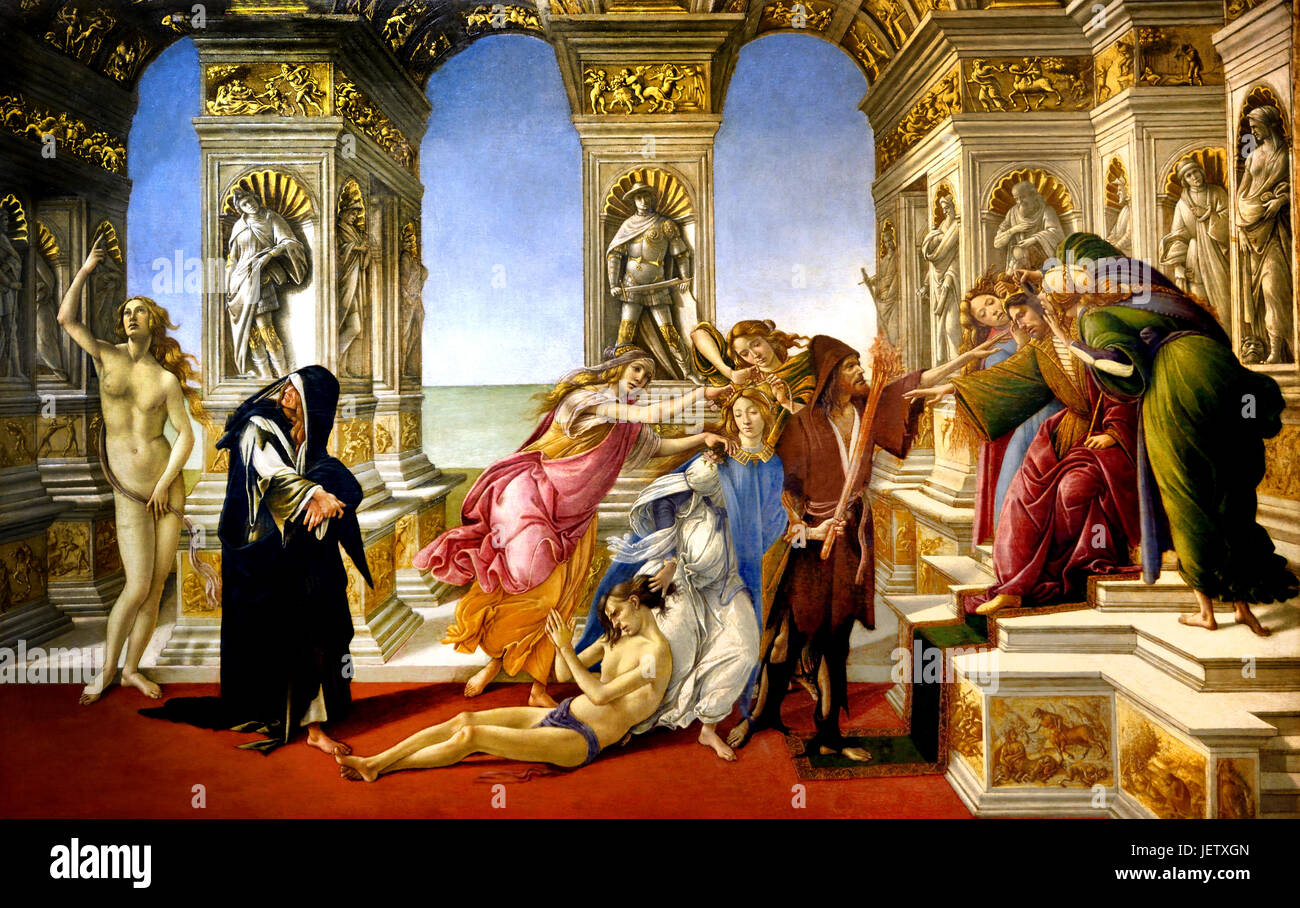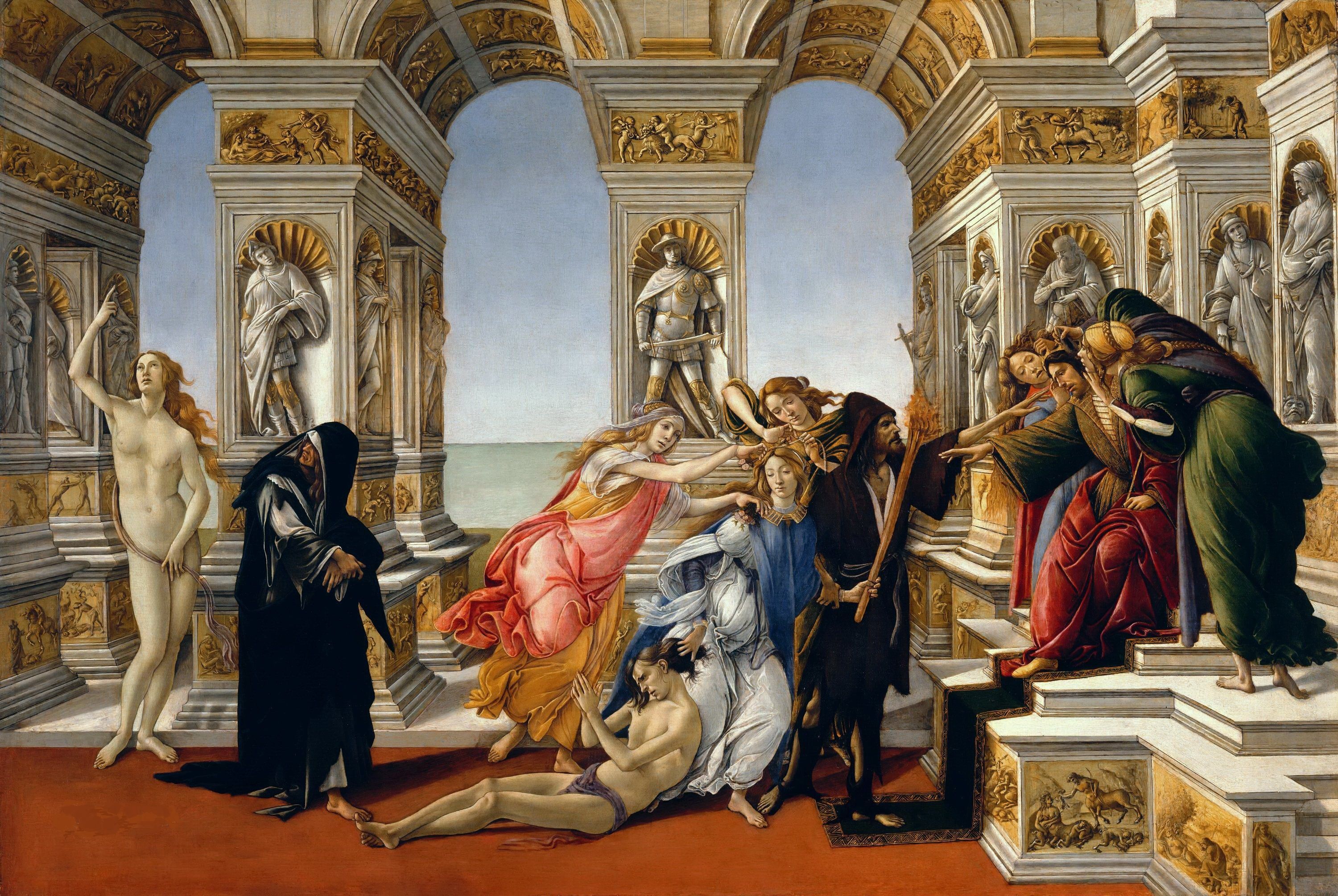La Calumnia De Apeles
Have you ever been the victim of false accusations or rumors? If so, you can relate to the story behind one of Sandro Botticelli's most famous paintings, "La calumnia de Apeles". This artwork tells a powerful narrative about the devastating impact of lies and deceit, and its message is just as relevant today as it was during the Renaissance period.
The Pain of False Accusations
Many of us have experienced the pain of being falsely accused of something. It can be incredibly disheartening when people believe things about us that simply aren't true. In "La calumnia de Apeles", Botticelli depicts the Greek painter Apeles being falsely accused of a crime. The painting shows the moment when Apeles is dragged before King Midas, who is presiding over the proceedings. In the background, a group of malevolent figures whisper rumors and lies into Midas's ear, poisoning his judgment.
The Target of "La calumnia de Apeles"
The painting's target is the destructive power of false accusations, and the human tendency to believe rumors without evidence. It's a warning about the dangers of being swayed by popular opinion, instead of thinking critically and making informed decisions. The painting's message is just as relevant today as it was hundreds of years ago. With the rise of social media and the 24-hour news cycle, false accusations and rumors can spread like wildfire and tarnish a person's reputation in an instant.
Main Points
In summary, "La calumnia de Apeles" is a powerful artwork that exposes the destructive power of lies and rumors. Its message is just as relevant today as it was during the Renaissance period, and it serves as a warning about the dangers of believing things without evidence. False accusations can be incredibly damaging to a person's reputation, and it's important to think critically and make informed decisions.
Personal Experience with La Calumnia de Apeles
Like many people, I've had my fair share of false accusations and rumors spread about me. It's a deeply painful experience that can leave lasting scars. When I look at "La calumnia de Apeles", I'm reminded of how important it is to stay true to yourself and not let other people's opinions define you. It's all too easy to get caught up in the drama and chaos of a false accusation, but the painting reminds us that ultimately, the truth will prevail.

Why "La calumnia de Apeles" Still Resonates Today
Despite being created hundreds of years ago, "La calumnia de Apeles" still resonates today because it speaks to a fundamental truth about human nature. We all want to be seen as upstanding citizens, and the idea of being falsely accused of something can be terrifying. In today's world of social media and instant gratification, it's more important than ever to be careful with what we say and do. False accusations can spread quickly and do lasting damage, both to individuals and society as a whole.

The History Behind "La calumnia de Apeles"
The painting "La calumnia de Apeles" was created by Sandro Botticelli in 1495, during the height of the Italian Renaissance. It was commissioned by the Italian ruler Lorenzo de' Medici and is currently housed at the Uffizi Gallery in Florence, Italy. The painting depicts a scene from Greek mythology in which the famous painter Apeles is falsely accused of a crime. The painting is filled with symbolism, including the group of figures whispering in King Midas's ear and the sword of injustice hanging over Apeles's head.

The Importance of the Painting's Message Today
The message of "La calumnia de Apeles" is just as important today as it was hundreds of years ago. With the rise of social media and the 24-hour news cycle, false accusations and rumors can spread like wildfire and tarnish a person's reputation in an instant. It's more important than ever to be vigilant about what we read and share online, and to think critically before jumping to conclusions. "La calumnia de Apeles" is a powerful reminder that the truth will always prevail, and that justice will ultimately prevail in the end.

Question and Answer
Q: Who commissioned "La calumnia de Apeles"?
A: The painting was commissioned by the Italian ruler Lorenzo de' Medici.
Q: What is the painting's message?
A: The painting warns of the destructive power of false accusations and the human tendency to believe rumors without evidence.
Q: What is the painting's historical context?
A: The painting was created during the Italian Renaissance, a time of great cultural and artistic upheaval. It's part of a larger body of work that explored themes of classical mythology and humanism.
Q: Why is "La calumnia de Apeles" still relevant today?
A: The painting's message is still relevant because false accusations and rumors can spread quickly and do lasting damage, both to individuals and society as a whole. It's more important than ever to think critically and make informed decisions.
Conclusion of La Calumnia de Apeles
"La calumnia de Apeles" is a powerful artwork that speaks to the destructive power of lies and rumors. Its message is just as important today as it was during the Renaissance period, and it serves as a reminder of the importance of staying true to yourself and thinking critically. In a world where false accusations and rumors can spread quickly and easily, it's more important than ever to be careful about what we say and do. The truth will always prevail, and justice will ultimately prevail in the end.
Gallery
Calumny Of Apelles 1495 Sandro Botticelli ( Alessandro Di Mariano

Photo Credit by: bing.com / botticelli apelles sandro calumny di 1495 alessandro mariano filipepi alamy
Análisis Técnico De "La Calumnia De Apeles" De Sandro Boticelli [Javi…

Photo Credit by: bing.com /
Sandro Botticelli. La Calumnia De Apeles, 1495. Galería Ufizzi

Photo Credit by: bing.com /
Noticias Falsas En La Historia

Photo Credit by: bing.com / falsas apeles calumnia
La Calumnia De Apeles. – Juanfernandezweb

Photo Credit by: bing.com / calumnia apeles sandro boticelli renacentista pictorica

Belum ada Komentar untuk "La Calumnia De Apeles"
Posting Komentar